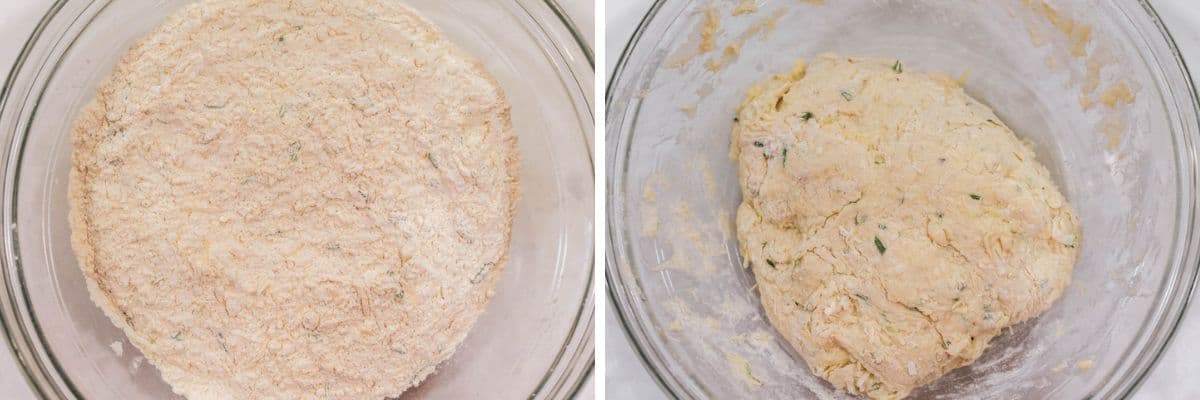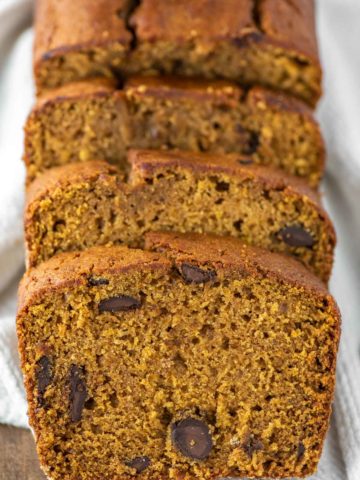This post may contain affiliate links. Please read my disclosure.
Upgrade your bread game with this effortless Dutch oven no-knead Rosemary Parmesan bread, a flavor-packed bread with minimal effort required.

When it comes to smells, there really isn't much better than homemade bread baking in the oven. And there are plenty of options out there - from chocolate brioche to jalapeño cheddar bread to honey beer bread to black pepper focaccia.
But my favorite way to make bread these days is in a Dutch oven. There is no kneading required. Simply mix the ingredients together, let it sit overnight and bake!
Why This Recipe Works
- Minimal effort - The no-knead method allows the dough to ferment and develop gluten on its own over time, reducing the need for extensive kneading.
- Dutch oven's magic - Baking in a Dutch oven creates a perfect steamy environment, promoting a crispy crust and a tender, well-risen interior.
- Foolproof - With clear instructions and consistent results, no-knead Dutch oven bread proves to be a reliable and successful baking method time and time again.
- Flavor combo - The marriage of fragrant rosemary and nutty Parmesan cheese creates a perfectly balanced bite.

Ingredient Notes
- All-purpose flour - All-purpose flour has just the right amount of protein for this bread.
- Salt - A crucial ingredient for flavor and gluten development. Fine sea salt or kosher salt are good choices.
- Yeast - Active dry yeast or instant yeast both work well for this recipe. If using active dry yeast, activate it in warm water before mixing with the other ingredients.
- Parmesan cheese - Opt for freshly grated Parmesan cheese to ensure maximum flavor. Avoid using pre-packaged, pre-shredded cheese, as it may contain additives that affect the texture and taste.
- Rosemary - Use fresh rosemary for the best flavor and aroma. Dried rosemary can be substituted but may have a slightly milder taste.
- Water: Use lukewarm water to activate the yeast properly and aid in gluten development.
- Olive Oil - Adds moisture at the end and helps the rosemary and Parmesan stick to the outside.
Step-by-Step Photos
Please note full ingredient list and instructions can be found in recipe card below.

Combine the flour, salt, yeast, Parmesan cheese, and rosemary in a large bowl. Add warm water, stirring with a spoon until the dough forms a wet and sticky ball.

After mixing, cover the bowl with plastic wrap and let it rest in a warm spot for 8-18 hours. The dough will rise, flatten at the top, and develop bubbles - longer resting times yield better results.
Deflate the dough then dust a parchment paper with flour. Transfer the dough onto the parchment, shaping it into a ball with floured hands. Cover with plastic wrap and let it rest for 30 minutes.
While the dough was resting, preheat the oven to 450°F. Place a 2.75-quart Dutch oven with its cover inside the oven and let it heat for 30 minutes.

Take out the Dutch oven from the oven. Place the dough (with the parchment beneath) into the Dutch oven, cover it, and bake for 45 minutes.
Uncover and bake for an additional 10-15 minutes until the top turns golden brown. Allow it to cool slightly before serving.
FAQs
It is a method of bread baking that uses a very long fermentation (rising) time instead of kneading to form the gluten strands that give the bread its texture. This dough has a low yeast content and is very wet.
A 2.75-quart Dutch oven is recommended for this recipe. Using a larger or smaller size may affect the baking results.
While you want the dough to rest for at least 8 hours, you don't want it to go longer than 24 hours either. I usually let my no-knead dough rest for about 18 hours.
I know not everyone has a Dutch oven. Luckily that isn't the only equipment you have to have. A deep oven-proof skillet can work as well as an oven-proof soup pot.
If you don't have lids you can cover with foil. An oven-safe casserole dish can work as well. Big thing for any of these is they have to be able to withstand 450°F.
The bread should have a deep golden-brown crust, and tapping the bottom should produce a hollow sound. An internal temperature of around 209°F (98°C) indicates it's done.
For the best experience, enjoy this bread right out of the oven. Although maintaining its crispy exterior and soft interior is challenging during storage, you can wrap the bread tightly in foil or plastic/beeswax wrap and store it at room temperature.
Consume within two days for optimal freshness, but it can still be enjoyed up to five days later. You can also freeze for up to 3 months and thaw at room temperature when ready to serve.
Pro Tips/Recipe Notes
- Want to try this with whole wheat flour? You can absolutely make up to half of the total flour whole wheat if you want. Add an additional 2 teaspoons water per cup of whole wheat flour to prevent the dough from being too dry.
- Use freshly grated cheese as it just tastes better.
- If using dried rosemary, reduce to a ⅓rd of the amount as it is more potent.
- Do not skip using the parchment paper when transferring the dough as it is quite sticky.
- Heating the Dutch oven ahead of time is important in creating the rustic texture of the bread.

Other Bread Recipes
If you’ve tried this rosemary Parmesan bread or any other recipe on Chisel & Fork, please let me know how it turned out in the comments below! You can also follow me on Facebook, Instagram, Pinterest and YouTube to see more tasty meals and anything else I'm up to.
Rosemary Parmesan Bread
Ingredients
- 3 cups all-purpose flour, plus more for shaping
- 1 ½ teaspoon salt or 2 teaspoon sea salt
- 1 teaspoon active dry yeast
- 1 ½ cups freshly grated Parmesan cheese + more for topping
- 1 ½ tablespoon fresh rosemary, finely chopped + more for topping
- 1 ½ cups warm water (105°F to 110°F)
- ½ tablespoon olive oil
Instructions
- In a large bowl, mix together the flour, salt, yeast, cheese and rosemary until mixed. Pour the warm water and use a spoon to stir until the dough forms a ball. The mixture will be wet and sticky to the touch.
- Cover the bowl with plastic wrap and set aside in a warm place for 8-18 hours, until the dough rises and flattens at the top with bubbles. (The longer the better).
- Heat the oven to 450°F. Once the oven is preheated, place a 2.75 quart Dutch oven with the cover on in the oven for 30 minutes.
- Punch the dough down and flour a sheet of parchment paper. Transfer the dough to the parchment and with your hands floured, shape the dough in a ball. Place some plastic wrap on top and let rest for 30 minutes. Remove the plastic wrap and rub the olive oil over the top of the dough and sprinkle some cheese and rosemary over it.
- Remove the Dutch oven from the oven. Transfer the dough with the parchment wrap beneath it. Cover the Dutch oven and bake for 45 minutes. Remove the cover and bake for another 10-15 minutes until the dough is golden brown on top. Cool slightly before serving.
Notes
- Want to try this with whole wheat flour? You can absolutely make up to half of the total flour whole wheat if you want. Add an additional 2 teaspoons water per cup of whole wheat flour to prevent the dough from being too dry.
- Use freshly grated cheese as it just tastes better.
- If using dried rosemary, reduce to a ⅓rd of the amount as it is more potent.
- Do not skip using the parchment paper when transferring the dough as it is quite sticky.
- Heating the Dutch oven ahead of time is important in creating the rustic texture of the bread.
- You know the bread is done when it reaches around 209 to 210°F inside. Yes you can just insert a thermometer to confirm.













Sarah Ann says
Following your recipe was straight forward. I mixed up the dough in the morning and let it rise all day. This being a snowy afternoon, I knew it would top off the baked lasagna I planned to make for dinner. When the lasagna was done, I jacked up the oven temperature and preheated my Dutch oven. By the time the lasagna cooled a bit and I threw together a quick salad, the bread was done too. Letting it rest was really hard to do…but I’m telling you, it surely turned out to be worth the wait!
Ryan says
So glad you liked it!